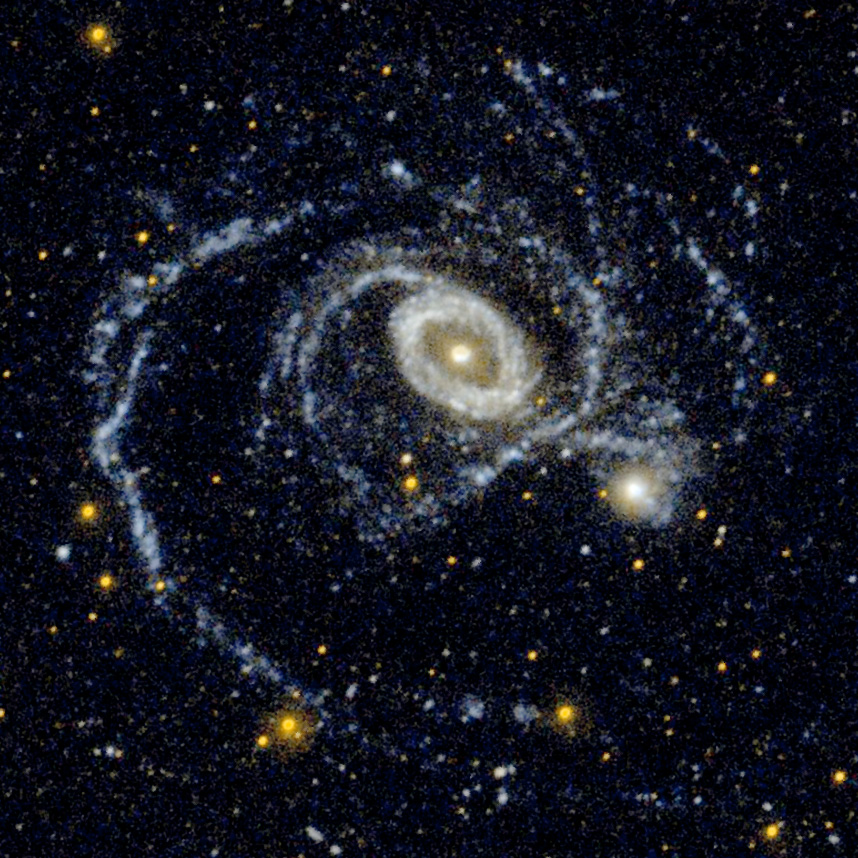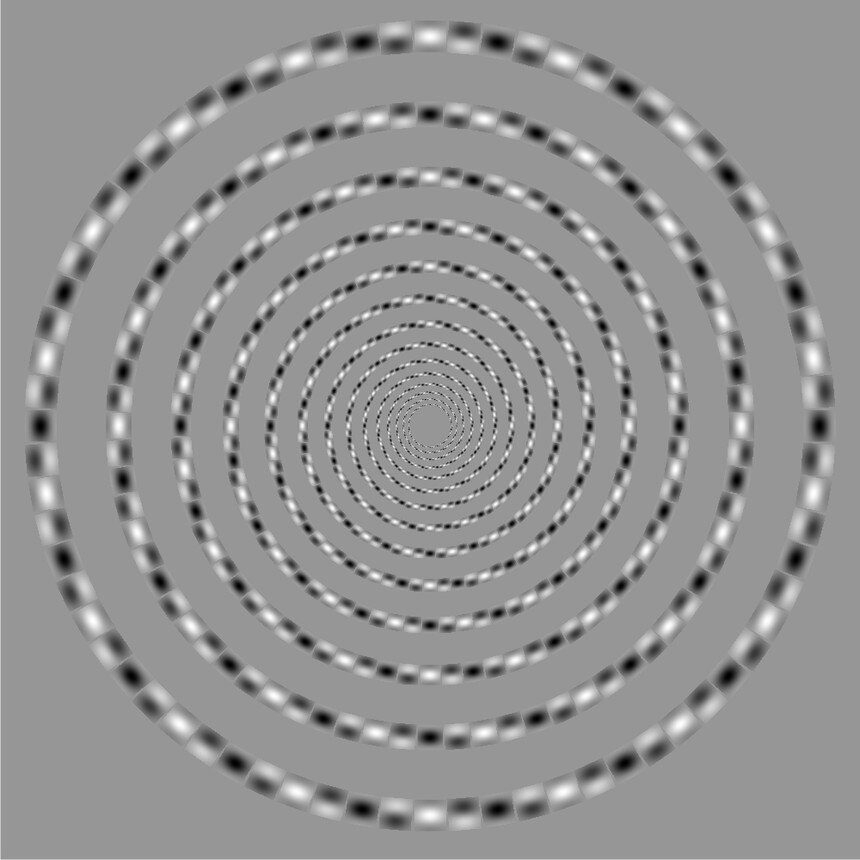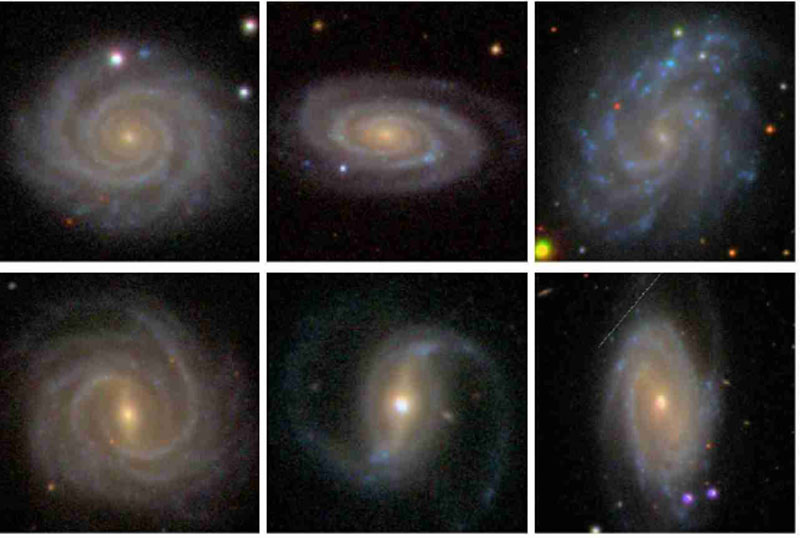ems57fcva wrote:
FWIW - I see in NGC 1512 the tail end of a galactic merger. The Inner Ring (whose context can be seen in the accompanying GALEX image) is just two spiral arms that start from the ends of the bar.
Indeed, many galactic rings are really overlapping spiral arms.
My belief is that spiral arms like there are the tidally distorted remains of two galaxies that captured each other and merged.
I don't think so. We see no sign that the well-ordered inner parts of NGC 1512 have been affected by a merger. On the other hand, the outer, extremely faint and very disordered outer spiral arms of NGC 1512 are clearly affected by the tidal effects of the galaxy's interactions with NGC 1510.
The bar started as a bridge between the cores of the galaxies, pulling material in from both. When the galaxies interact strongly enough, this bridge starts to dominate things and begins forming a core of its own. That somehow draws the cores out of the other two galaxies and into this new core. the nuclear ring is like a galactic accretion disk for material flowing from the outer regions and into this new core.
I don't think that there are any observations that support this hypothesis.
For now, all that I can say is that I have seen various pictures of merging galaxies that lead me to be comfortable with merging galaxies becoming a barred spiral that then over time relaxes into a normal spiral.
Barred spirals are more common in the nearby universe than they were in the past, in the very distant universe. So there are no signs that barred galaxies typically lose their bars and become nonbarred over time.
NASA wrote:
In a landmark study of more than 2,000 spiral galaxies from the largest galaxy census conducted by NASA's Hubble Space Telescope, astronomers found that
so-called barred spiral galaxies were far less plentiful 7 billion years ago than they are today, in the local universe.
ems57fcva wrote:However, I have yet to see a picture that says to me that here are the central objects moving down the bridge/bar. Instead all that I ever see are streams of gas going down the bar to the center. So I suspect that the central objects dissipate instead of move, but cannot even begin to prove that at this time.
Self-assessment: A neat idea. But extraordinary claims require extraordinary evidence. And I do not have that ... yet.
Good! I like your interest in space, your interest in galaxies, your willingness to speculate, and your self-reflection and humility.

As for myself, I don't know where galactic bars come from, and I'm not too willing to speculate. I suspect that they form naturally as stellar orbits and gas movements in galaxies interact, set up feedback and create self-regulating periods. But I'll leave it to the mathematicians here to say if I am even a little bit right or just plain mistaken.
A few more points here.
Caltech.edu wrote:
Durbala et al. (2008) analyzed the photometric properties of 100 isolated Sb-Sc AMIGA galaxies, and found that a majority have pseudobulges rather than classical bulges. In comparing the properties of isolated galaxies with a sample of Sb-Sc galaxies selected without an isolation criterion, Durbala et al. found that
isolated spirals have longer bars and, using CAS parameters, also less asymmetry, central concentration, and clumpiness,
Super-sized spirals with double nuclei.
Photo: Sloan Digital Sky Survey.
But as for mergers, there really is a very rare class of super-sized spiral galaxies that just possibly may owe their humongous size to a galactic mergers.
Americaspace.com wrote:
By far, some of the most massive and luminous galaxies known to date are ellipticals.
...
Ogle and colleagues expected to only find similar supergiants like M87 in a sample of nearly 800,000 galaxies that they extracted from the NED database for their research.
Yet, to their surprise, their search revealed a total of 53 spiral galaxies with sizes and luminosities that by far exceeded that of spirals like our own. Dubbed ‘super spirals’ by the researchers, these newly found behemoths which lie between 1.2 and 3.5 billion light-years away, were found to be eight and fourteen times brighter than the Milky Way while also exhibiting a star formation rate that was up to 30 times higher.
...
One of the things that stands out regarding these newly found super spiral galaxies, is the strange fact that four of them appear to have two galactic nuclei, making them look like two egg yolks in a frying pan, similar to what has also been observed in recent years in a handful of much smaller spirals. Could this be evidence of an ongoing galaxy merger?
...
“Super spirals display a range of morphologies, from flocculent to grand-design spiral patterns”, write the researchers in their study which was published at The Astrophysical Journal. “At least 9 super spirals have prominent stellar bars visible in the SDSS images.
...
Whatever the case may be, the finding of just 53 such galaxies out of a total of 800,000 suggests that super spirals are extremely rare specimens in the wider population of the galactic zoo.
Ann
 Spiral Galaxy NGC 1512: The Inner Ring
Spiral Galaxy NGC 1512: The Inner Ring



 FWIW - I see in NGC 1512 the tail end of a galactic merger. The Inner Ring (whose context can be seen in the accompanying GALEX image) is just two spiral arms that start from the ends of the bar. That they overlap and become more diffuse afterwards does not change their state. In fact, the overlap may be what makes the Inner Ring so prominent. And the disruption caused by NGC 1510 (to the right and slightly below the center of NGC 1512) may be part of what make NGC 1512 so weird,
FWIW - I see in NGC 1512 the tail end of a galactic merger. The Inner Ring (whose context can be seen in the accompanying GALEX image) is just two spiral arms that start from the ends of the bar. That they overlap and become more diffuse afterwards does not change their state. In fact, the overlap may be what makes the Inner Ring so prominent. And the disruption caused by NGC 1510 (to the right and slightly below the center of NGC 1512) may be part of what make NGC 1512 so weird,
